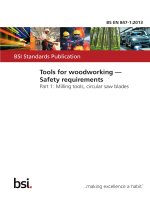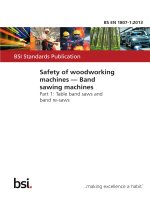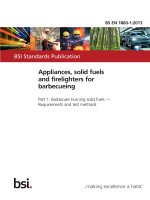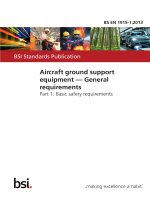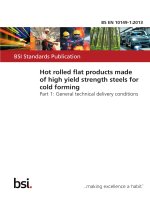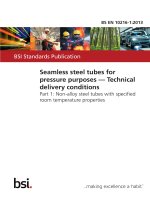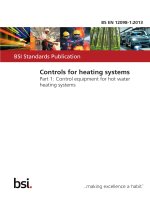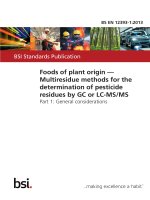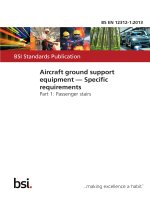Bsi bs en 62321 1 2013
Bạn đang xem bản rút gọn của tài liệu. Xem và tải ngay bản đầy đủ của tài liệu tại đây (1.1 MB, 20 trang )
BS EN 62321-1:2013
BSI Standards Publication
Determination of certain
substances in electrotechnical products
Part 1 Introduction and Overview
BS EN 62321-1:2013
BRITISH STANDARD
National foreword
This British Standard is the UK implementation of EN 62321-1:2013.
It is identical to IEC 62321-1:2013. Together with BS EN 62321-2:2013,
BS EN 62321-3-1:2013, BS EN 62321-3-2:2013, BS EN 62321-4:2013,
BS EN 62321-5:2013, BS EN 62321-6, BS EN 62321-7-1, BS EN 62321-7-2 and
BS EN 62321-8 it supersedes BS EN 62321:2009, which will be withdrawn
upon publication of all parts of the BS EN 62321 series.
The UK participation in its preparation was entrusted to Technical
Committee GEL/111, Electrotechnical environment committee.
A list of organizations represented on this committee can be obtained
on request to its secretary.
This publication does not purport to include all the necessary provisions
of a contract. Users are responsible for its correct application.
© The British Standards Institution 2013.
Published by BSI Standards Limited 2013
ISBN 978 0 580 71818 2
ICS 13.020; 43.040.10
Compliance with a British Standard cannot confer immunity from
legal obligations.
This British Standard was published under the authority of the Standards
Policy and Strategy Committee on 30 September 2013.
Amendments/corrigenda issued since publication
Date
Text affected
BS EN 62321-1:2013
EN 62321-1
EUROPEAN STANDARD
NORME EUROPÉENNE
EUROPÄISCHE NORM
July 2013
ICS 13.020; 43.040.10
Supersedes EN 62321:2009 (partially)
English version
Determination of certain substances in electrotechnical products Part 1: Introduction and overview
(IEC 62321-1:2013)
Détermination de certaines substances
dans les produits électrotechniques Partie 1: Introduction et présentation
(CEI 62321-1:2013)
Verfahren zur Bestimmung von
bestimmten Substanzen in Produkten der
Elektrotechnik Teil 1: Einleitung und Übersicht
(IEC 62321-1:2013)
This European Standard was approved by CENELEC on 2013-06-21. CENELEC members are bound to comply
with the CEN/CENELEC Internal Regulations which stipulate the conditions for giving this European Standard
the status of a national standard without any alteration.
Up-to-date lists and bibliographical references concerning such national standards may be obtained on
application to the CEN-CENELEC Management Centre or to any CENELEC member.
This European Standard exists in three official versions (English, French, German). A version in any other
language made by translation under the responsibility of a CENELEC member into its own language and notified
to the CEN-CENELEC Management Centre has the same status as the official versions.
CENELEC members are the national electrotechnical committees of Austria, Belgium, Bulgaria, Croatia, Cyprus,
the Czech Republic, Denmark, Estonia, Finland, Former Yugoslav Republic of Macedonia, France, Germany,
Greece, Hungary, Iceland, Ireland, Italy, Latvia, Lithuania, Luxembourg, Malta, the Netherlands, Norway, Poland,
Portugal, Romania, Slovakia, Slovenia, Spain, Sweden, Switzerland, Turkey and the United Kingdom.
CENELEC
European Committee for Electrotechnical Standardization
Comité Européen de Normalisation Electrotechnique
Europäisches Komitee für Elektrotechnische Normung
Management Centre: Avenue Marnix 17, B - 1000 Brussels
© 2013 CENELEC -
All rights of exploitation in any form and by any means reserved worldwide for CENELEC members.
Ref. No. EN 62321-1:2013 E
BS EN 62321-1:2013
EN 62321-1:2013
-2-
Foreword
The text of document 111/295/FDIS, future edition 1 of IEC 62321-1, prepared by IEC TC 111
"Environmental standardization for electrical and electronic products and systems" was submitted to the
IEC-CENELEC parallel vote and approved by CENELEC as EN 62321-1:2013.
The following dates are fixed:
•
•
latest date by which the document has
to be implemented at national level by
publication of an identical national
standard or by endorsement
latest date by which the national
standards conflicting with the
document have to be withdrawn
(dop)
2014-03-21
(dow)
2016-06-21
EN 62321-1:2013 is a partial replacement of EN 62321:2009, forming a structural revision and replacing
Clauses 1 to 4.
Attention is drawn to the possibility that some of the elements of this document may be the subject of
patent rights. CENELEC [and/or CEN] shall not be held responsible for identifying any or all such patent
rights.
Endorsement notice
The text of the International Standard IEC 62321-1:2013 was approved by CENELEC as a European
Standard without any modification.
In the official version, for Bibliography, the following note has to be added for the standard indicated:
IEC 60730-1:2010
NOTE Harmonised as EN 60730-1:2011 (modified).
BS EN 62321-1:2013
EN 62321-1:2013
-3-
Annex ZA
(normative)
Normative references to international publications
with their corresponding European publications
The following documents, in whole or in part, are normatively referenced in this document and are
indispensable for its application. For dated references, only the edition cited applies. For undated
references, the latest edition of the referenced document (including any amendments) applies.
NOTE When an international publication has been modified by common modifications, indicated by (mod), the relevant EN/HD
applies.
Publication
Year
Title
EN/HD
ISO/IEC 17025
-
General requirements for the competence of EN ISO/IEC 17025 testing and calibration laboratories
ISO 78-2
1999
Chemistry - Layouts for standards Part 2: Methods of chemical analysis
-
Year
-
–2–
BS EN 62321-1:2013
62321-1 © IEC:2013
CONTENTS
INTRODUCTION ..................................................................................................................... 5
1
Scope ............................................................................................................................... 6
2
Normative references ....................................................................................................... 6
3
Terms, definitions and abbreviations ................................................................................ 6
4
3.1 Terms and definitions .............................................................................................. 6
3.2 Abbreviations .......................................................................................................... 8
Test methods – Overview ................................................................................................. 8
4.1 Field of application .................................................................................................. 8
4.2 Sample .................................................................................................................... 9
4.3 Test methods – Flow chart ..................................................................................... 9
4.4 Quality assurance and control ............................................................................... 12
4.5 Blank solution ........................................................................................................ 12
4.6 Adjustment to the matrix ........................................................................................ 12
4.7 Limits of detection (LOD) and limits of quantification (LOQ) ................................... 12
4.8 Test report ............................................................................................................ 13
4.9 Alternative test methods ........................................................................................ 13
Annex A (informative) Limit of detection (LOD) or method detection limit (MDL) –
Example of calculation .......................................................................................................... 14
Bibliography .......................................................................................................................... 16
Figure 1 – Flow chart of the test methods ............................................................................. 10
Table 1 – Overview of typical screening and verification testing procedure elements –
Preparation ........................................................................................................................... 11
Table 2 – Overview of typical screening and verification testing procedure elements –
Substance type ..................................................................................................................... 12
Table A.1 – Experimental results .......................................................................................... 14
Table A.2 – Students t-values (t-statistic) .............................................................................. 14
Table A.3 – Calculation results ............................................................................................. 15
BS EN 62321-1:2013
62321-1 © IEC:2013
–5–
INTRODUCTION
The widespread use of electrotechnical products has drawn increased attention to their impact
on the environment. In many countries this has resulted in the adoption of regulations
affecting wastes, substances and energy use of electrotechnical products.
The use of certain substances (e.g. lead (Pb), cadmium (Cd) and polybrominated diphenyl
ethers (PBDEs)) in electrotechnical products, is a source of concern in current and proposed
regional legislation.
The purpose of the IEC 62321 series is therefore to provide test methods that will allow the
electrotechnical industry to determine the levels of certain substances of concern in
electrotechnical products on a consistent global basis.
The first edition of IEC 62321:2008 was a single 'stand-alone' standard that included an
introduction, an overview of test methods, a mechanical sample preparation as well as various
test method clauses.
The structure of the new multi-part IEC 62321 series comprises:
–
Determination of certain substances in electrotechnical products – Part 1: Introduction and
overview.
–
Determination of certain substances in electrotechnical products – Part 2: Disassembly,
disjointment and mechanical sample preparation.
The remaining parts specify screening and verification test methods for the determination of
certain substances, each part representing a given substance.
WARNING – Persons using this International Standard should be familiar with normal
laboratory practice. This standard does not purport to address all of the safety
problems, if any, associated with its use. It is the responsibility of the user to establish
appropriate safety and health practices and to ensure compliance with any national
regulatory conditions.
–6–
BS EN 62321-1:2013
62321-1 © IEC:2013
DETERMINATION OF CERTAIN SUBSTANCES
IN ELECTROTECHNICAL PRODUCTS –
Part 1: Introduction and overview
1
Scope
This part of IEC 62321 refers to the sample as the object to be processed and measured. The
nature of the sample and the manner in which it is acquired is defined by the entity carrying
out the tests and not by this standard.
It is noted that the selection of the sample may affect the interpretation of the test results.
While this standard provides guidance on the disassembly procedure employed for obtaining
a sample, it does not determine or specify:
•
the level of the disassembly procedure required for obtaining a sample;
•
the definition of a “unit” or “homogenous material” as the sample;
•
conformity assessment procedures.
NOTE
2
Further guidance on assessment procedures may be found in IEC/TR 62476 [2].
Normative references
The following documents, in whole or in part, are normatively referenced in this document and
are indispensable for its application. For dated references, only the edition cited applies. For
undated references, the latest edition of the referenced document (including any
amendments) applies.
ISO 78-2:1999, Chemistry – Layouts for standards – Part 2: Methods of chemical analysis
ISO/IEC 17025, General requirements for the competence of testing and calibration
laboratories
3
3.1
Terms, definitions and abbreviations
Terms and definitions
For the purposes of this document, the following terms and definitions apply.
3.1.1
analyte
substance to be measured
3.1.2
electronics
material used in electrical or electronic equipment that is not metal or plastic (e.g. ceramic) or
not uniform in composition throughout and cannot be practically disassembled to individual
discrete materials
EXAMPLE Resistors, capacitors, diodes, integrated circuits, hybrids, application-specific integrated circuits,
wound components, relays and their materials.
BS EN 62321-1:2013
62321-1 © IEC:2013
–7–
3.1.3
field replaceable unit
part, component or subassembly that is easily removed (mechanically disjointed) using
ordinary tools
Note 1 to entry: “Easily removed” means using ordinary tools to perform such functions as screwing or
disconnecting, and only without irreversibly destroying the unit.
[SOURCE: IEC Guide 114:2005, definition 3.7] [3]
3.1.4
matrix
substance or mixture and its form or state in which analyte is embedded or to which analyte is
attached
3.1.5
performance-based measurement system
set of processes wherein the data needs, mandates or limitations of a program or project are
specified, serving as criteria for selecting appropriate methods to meet those needs in a costeffective manner
Note 1 to entry: The criteria may be published in regulations, technical guidance documents, permits, work plans
or enforcement orders.
3.1.6
precision
closeness of agreement between independent test results obtained under stipulated
conditions
3.1.7
reference material
material, sufficiently homogeneous and stable with reference to specified properties, which
has been established to be fit for its intended use in measurement or in examination of
nominal properties
3.1.8
repeatability
precision under repeatability conditions
[SOURCE: ISO 5725-1:1994, definition 3.13] [4]
3.1.9
reproducibility
precision under reproducibility conditions
[SOURCE: ISO 5725-1:1994, definition 3.17]
3.1.10
screening
analytical procedure to determine the presence or absence of substances in the
representative part or section of a product, relative to the value or values chosen as the
criterion for presence, absence or further testing
Note 1 to entry: If the screening method produces values that are not conclusive, then additional analysis or other
follow-up actions may be necessary to make a final presence/absence decision.
–8–
3.2
Abbreviations
AAS
Atomic Absorption Spectrometry
C-IC
Combustion – Ion chromatography
CV-AAS
Cold Vapour Atomic Absorption Spectrometry
CV-AFS
Cold Vapour Atomic Fluorescence Spectroscopy
EPA
Environmental Protection Agency
FRU
Field replaceable unit
GC-MS
Gas chromatography – mass spectrometry
GLP
Good laboratory practice
HPLC-UV
High-performance liquid chromatography – ultraviolet
IC
Ion Chromatography
IAMS
Ion attached mass spectrometry
ICP-MS
Inductively coupled plasma mass spectrometry
ICP-OES
Inductively coupled plasma optical emission spectrometry
IS
Internal standard
IUPAC
International Union of Pure and Applied Chemistry
LOD
Limit of detection
LOQ
Limit of quantification
MDL
Method detection limit
PBB
Polybrominated biphenyl
PBDE
Polybrominated diphenyl ether
PBMS
Performance-based measurement system
PWB
Printed wiring board
QC
Quality control
UV-VIS
Ultraviolet–visible Spectroscopy
XRF
X-ray fluorescence
4
4.1
BS EN 62321-1:2013
62321-1 © IEC:2013
Test methods – Overview
Field of application
The contents of the test methods to determine the levels of certain substances are grouped in
two important steps:
a) analytical test methods;
b) laboratory implementation.
Analytical test methods were developed and validated to ensure their suitability to the task.
The structure of each of the test methods are generally aligned in accordance with ISO 78-2
where applicable, i.e.:
–
Foreword
–
Introduction
–
Title
–
Warnings
–
Scope
–
Normative references
–
Definitions
BS EN 62321-1:2013
62321-1 © IEC:2013
–
Principle
–
Reactions
–
Reagents and materials
–
Apparatus
–
Sampling
–
Procedure
–
Calculation
–
Precision
–
Quality assurance and control protocols
–
Special cases
–
Test report
–
Annexes
–
Bibliography
–9–
Laboratory implementation is not covered in this standard, as laboratories are able to
implement test methods described using test methods and standards addressed in other
sources. The implementation step includes suitable quality assurance measures and a
validation protocol that documents the performance of the analytical method using the
instruments in the laboratory. Quality assurance systems such as good laboratory practice
(GLP) and/or accreditation to similar international or national systems (e.g. ISO 17025) are
strongly encouraged.
4.2
Sample
This standard refers to the sample as the object to be processed and measured according to
the test methods to determine the levels of certain substances. A sample can either be a
polymer, a metal or electronics.
The entity carrying out the test methods shall define the sample and how to produce it with
respect to applicable normative documents.
NOTE The entity can either be the organization commissioning the work or the organization carrying out the work.
In practice, the requestor and the analyst will agree on the sample to be taken.
The entity may decide to prepare a sample from homogenous material. For this kind of
sample, the test methods applicable to metals or polymers are especially suitable.
The entity may also decide to prepare a sample from an electronic component, an electronic
assembly or a FRU. For this kind of sample, the test methods applicable to electronics are
especially suitable.
4.3
Test methods – Flow chart
Figure 1 gives a flow chart of the test methods to determine the levels of certain substances
in electrotechnical products.
BS EN 62321-1:2013
62321-1 © IEC:2013
– 10 –
Yes
Sample
uniform?
No
Samples
Metallic
materials,
polymer
materials
Electronics
(PWB/
component)
Non-destructive
sample
preparation
Mechanical
sample
preparation
Yes
Meets
limits?
Screening
procedure
Entity based
conforming
sample
No
Entity based
non conforming
sample
Pass
Entity based
conforming
sample
Fail
Entity based
non conforming
sample
Fail
Yes
Screening?
Further
testing?
No
Mechanical
sample
preparation
Pass
Verification test
procedure –
Various methods
Meets
limits?
Decision
Decision criteria will
be entity based
IEC 2244/08
Figure 1 – Flow chart of the test methods
After obtaining the sample, a decision is taken as to whether the screening procedure or the
verification procedure using a variety of test methods will be used.
The use of the term “screening” for the evaluation of certain substances (e.g. lead, cadmium,
hexavalent chromium, etc.) in electrical and electronic equipment is widely used in reference
to analytical testing methods. Screening methods provide the analyst a convenient approach
to evaluate for the presence or quantity of certain substance(s) in samples. Screening may
employ qualitative or semi-quantitative methods. In some cases, a quantitative method may
be used for screening purposes if the actual targeted substance(s) are difficult to analyse
directly (e.g. hexavalent Cr).
Depending on the screening results however, additional analysis methods may need to be
employed to definitively verify the presence or quantity of certain substances. These definitive
analysis methods are referred to as verification methods.
While X-ray fluorescence spectrometry (XRF) is the tool most commonly associated with the
screening approach, it is not limited to this analytical measurement technique. Users of this
family of standards will understand that multiple measurement techniques can be employed
for the purpose of “screening”.
Screening for hexavalent chromium (Cr VI) for example, can be accomplished by a total
chromium measurement using a non-destructive XRF analysis method. Similarly, total
chromium analysis could be performed by a destructive analysis using an inductively coupled
plasma measurement method. Either measurement can be effectively employed to evaluate
for the presence or quantity of hexavalent chromium since the concentration of the hexavalent
species can be no greater than the total chromium concentration value.
Likewise, a total bromine measurement using a non-destructive XRF analysis method or C-IC
method can be used in the same fashion. Either measurement can be effectively employed to
evaluate for the presence or quantity (PBBs) or (PBDEs) in a sample when relating the total
bromine content to the composition of these compounds.
In both examples however, the detection of elevated total element levels requires additional
verification method analysis (e.g. UV-VIS or GC-MS techniques) to confirm the potential
presence or quantity of hexavalent chromium (Cr +IV) or PBB/PBDE compound species.
BS EN 62321-1:2013
62321-1 © IEC:2013
– 11 –
It can therefore be seen that the prudent analyst can effectively employ different screening
procedures to achieve the same result.
The screening procedure may be carried out either by directly measuring the sample (nondestructive sample preparation) or by destroying the sample to make it uniform (mechanical
sample preparation). This decision shall be made by judging the uniformity of the sample. A
screening of representative samples of many uniform materials (such as polymers, alloys,
glass) may be carried out non-destructively, while for other more complex samples (such as a
FRU), mechanical sample preparation may be an appropriate solution. Mechanical sample
preparation is the same for both the screening and the verification test procedure.
Verification test procedures are often employed to confirm the presence or quantity of certain
substances of concern after a screening procedure has been performed (e.g. to determine if
the source of “screened” bromine is from a bromine compound of concern). Alternatively,
verification test procedures can be performed independent of a screening procedure.
Verification procedures are typically performed after mechanical and chemical sample
preparation using a variety of test methods tailored to the substances of concern and the
sample, which can be a polymer, a metal or electronics.
Tables 1 and 2 give an overview of typical screening/verification test methods, which are
described in detail in the individual substance test method parts of this standard.
Table 1 – Overview of typical screening and verification
testing procedure elements – Preparation
Procedure
Sample preparation
Polymers
Metals
Electronics
(PWBs/components)
Non destructive
No preparation
No preparation
No preparation
Mechanical sample
preparation
Grinding or milling
Grinding or milling
Grinding or milling
Sample
Preparation
Chemical sample
preparation
• Aqueous/alkaline
extraction
• Aqueous/alkaline
extraction
• Acid digestion
• Acid digestion
• Dry ashing
• Organic solvent/
extraction
• Organic solvent
extraction
• Combustion/
extraction
• Thermal goldamalgamation
Acid digestion
• Combustion/extract
ion
BS EN 62321-1:2013
62321-1 © IEC:2013
– 12 –
Table 2 – Overview of typical screening and verification
testing procedure elements – Substance type
Procedure
Substance type
Organic compounds
(e.g. PBDEs)
Analytical
measurement
Elemental bromine
Ionic species
(e.g. Cr +VI
Elemental (metals)
analysis
Polymers
•
GC-MS
•
IAMS
•
HPLC-UV
•
XRF
•
IC
Colorimetry/UV-VIS
Metals
Electronics
(PWBs/components)
• GC-MS
NA
• IAMS
• HPLC-UV
NA
Colorimetry/UV-VIS
• XRF
• IC
Colorimetry
XRF, AAS, CV-AAS, CV-AFS, ICP-OES and ICP-MS
(e.g. Pb, Cd)
After the verification procedure has been carried out, it shall be decided whether the sample
meets the limits based on the entity’s criteria for certain substances.
4.4
Quality assurance and control
Where applicable, the quality assurance and control clauses of the individual test method
standards shall include control sample requirements regarding testing frequency and
acceptance criteria. These clauses shall also include method specific quality control concerns
regarding the determination of limits of detection (LOD) and limits of quantification
(LOQ). Where applicable, the LOD and LOQ section shall be consistent with the descriptions
in 4.7. Examples of other method-specific quality control concerns include requirements
regarding method blanks, calibration check standards, spike or surrogate samples, internal
standard responses and the like.
4.5
Blank solution
Where applicable, the precision clause of the individual test method standards shall include
repeatability and reproducibility statements (see Annex B of ISO 78-2:1999) supported by
statistical data derived from interlaboratory study or the equivalent.
4.6
Adjustment to the matrix
Test methods for certain substances that are present at relatively low levels amongst other
chemical elements or compounds at relatively high concentrations, or those that represent the
major constituent of the sample, are very often material or matrix dependent. Therefore, the
test methods shall be adjusted to the materials to be tested, either by introducing the
appropriate blanks and matrix-adjusted calibration samples, or by a preparation step that
separates the analyte from the adherent materials or the main matrix. The main material types
(or matrices) in electronic equipment are polymers (mostly technical polymers containing
additives and sometimes having coated surfaces), metals or alloys (they may also be coated)
and electronics. Matrix adjustment may be difficult for electronic products.
4.7
Limits of detection (LOD) and limits of quantification (LOQ)
In its simplest form, a limit of detection (LOD) or method detection limit (MDL) is typically
described as the lowest amount or concentration of analyte in a test sample that can be
reliably differentiated from zero for a given measurement system.
Instrument detection limits represent an instrument’s ability to differentiate low concentrations
of analytes from “zero” in a blank or standard solution, and are commonly used by
manufacturers to demonstrate the measurement capability of a system (e.g. atomic absorption
BS EN 62321-1:2013
62321-1 © IEC:2013
– 13 –
spectrometer). Whilst instrument detection limits are useful, they are often considerably lower
than a limit of detection representing a complete analytical measurement process.
Complete analytical method detection limits are most appropriately determined experimentally
by performing replicate, independent measurements on low-level or fortified sample matrices
(e.g. plastic) carried out through the entire test procedure, including sample digestion or
extraction. A minimum of six replicates and analyte concentrations of 3 to 5 times the
estimated method detection limit have been suggested as suitable for this analysis. The
complete method detection limit for an entire test procedure is determined by multiplying the
standard deviation of the replicates by an appropriate factor. IUPAC recommends a factor of
3 for a minimum of six replicates, whilst EPA utilizes a one-sided confidence interval with the
multiplier equal to Student’s t value chosen for the number of replicates and the level of
confidence (e.g. t = 3,36 for six replicates for 99 % confidence).
NOTE
An illustrative calculation example is given in Annex A.
The limit of quantification (LOQ) or estimated quantitation limit for a given measurement
system is typically described as the lowest concentration that can be reliably determined
within specified or acceptable limits of precision during routine laboratory operating conditions.
The acceptable precision limit is often defined as 10 % relative standard deviation or simply
expressed as a fixed multiple (2 to 10) of the method detection limit.
4.8
Test report
The work carried out by the testing laboratory shall be covered by a report that accurately,
clearly and unambiguously presents the test results and other relevant information. Each test
report shall include at least the following information:
a) name, address and location of any laboratory involved in the analysis and name of the
operator;
b) date of receipt of sample and date(s) of performance of test(s);
c) unique identification of report (such as a serial number) and of each page and total
number of pages of the report;
d) description and identification of the sample, including a description of any product
disassembly performed to acquire the test sample;
e) a reference to this standard, the method used or performance-based equivalent (including
digestion method(s) and equipment);
f)
the limit of detection (LOD) or limit of quantification (LOQ);
g) the results of the test expressed as milligram/kilogram (mg/kg) in samples tested;
h) any details not specified in this standard which are optional, and any other factors that
may have affected the results. Any deviation, by agreement or otherwise, from the test
procedure specified here.
The results of all quality control (QC) tests (e.g. results from method blanks, matrix spikes,
etc.) and a list of reference materials used and their origin shall be available upon request.
Corrections or additions to a test report after issue shall be made only in a further document
suitably marked, e.g. “Amendment/Addendum to test report serial number XXX” (or as
otherwise identified), and shall meet the relevant requirements of 4.2 to 4.6).
4.9
Alternative test methods
Alternative test methods, digestion methods or analytical techniques may be utilized once the
performance effectiveness has been validated according to PBMS criteria, referenced in the
quality control clauses of the test methods. Any deviation from the described test methods
shall be evaluated and documented in the test report.
BS EN 62321-1:2013
62321-1 © IEC:2013
– 14 –
Annex A
(informative)
Limit of detection (LOD) or method detection limit (MDL) –
Example of calculation
A sample containing an amount (~9,5 mg/kg) of cadmium approximately 3 to 5 times the
estimated method detection limit (~2 mg/kg) underwent nine (9) separate digestions and
quantitative measurements. The results are shown in Table A.1.
Table A.1 – Experimental results
Replicate (digestion) number
Measured cadmium content
mg/kg
1
9,49
2
10,20
3
9,79
4
9,44
5
9,42
6
9,80
7
9,94
8
8,89
9
10,20
The limit of detection (LOD) or method detection limit (MDL) was determined using the
appropriate student's t-value (t-statistic) and formula shown in Table A.2 and Formula (A.1).
Table A.2 – Students t-values ( t -statistic)
No. of samples
t- statistic (n-1, α = 0,99)
3
6,96
4
4,54
5
3,75
6
3,36
7
3,14
8
3,00
9
2,90
10
2,82
LOD or MDL = t-statistic × standard deviation (s n-1 )
(A.1)
The limit of quantification (LOQ) or estimated quantitation limit is expressed as a fixed multiple
(5) of the limit of detection (LOD) or method detection limit (MDL) as shown in Table A.3.
BS EN 62321-1:2013
62321-1 © IEC:2013
– 15 –
Table A.3 – Calculation results
Mean
9,69 mg/kg
t-statistic (n-1, α = 0,99)
2,90
Standard deviation (s n-1 )
0,42 mg/kg
LOD or MDL
1,22 mg/kg
LOQ @ 5x MDL
6,09 mg/kg
Based on the results of the calculations, it is appropriate to quote the estimated LOD as
1,2 mg/kg and the estimated LOQ as 6.0 mg/kg.
– 16 –
BS EN 62321-1:2013
62321-1 © IEC:2013
Bibliography
[1]
IEC/TR 62476:2010, Guidance for evaluation of products with respect to substanceuse restrictions in electrical and electronic products
[2]
IEC Guide 114:2005, Environmentally conscious design – Integrating environmental
aspects into design and development of electrotechnical products
(withdrawn)
[3]
ISO 5725-1:1994, Accuracy (trueness and precision) of measurement methods and
results — Part 1: General principles and definitions
Additional non-cited references
ISO 5725 (all parts), Accuracy (trueness and precision) of measurement methods and
results
IEC 60730-1:2010, Automatic electrical controls for household and similar use – Part 1:
General requirements
IEC/TS 62239:2008, Process management for avionics – Preparation of an electronic
components management plan
ISO 6206, Chemical products for industrial use – Sampling – Vocabulary
ISO/IEC Guide 98-3, Uncertainty of measurement – Part 3: Guide to the expression of
uncertainty in measurement (GUM:1995)
ISO/IEC Guide 99, International vocabulary of metrology – Basic and general concepts
and associated terms (VIM)
ISO Guide 30, Terms and definitions used in connection with reference materials
ISO Guide 32, Calibration in analytical chemistry and use of certified reference
materials
BECKER, D., Use of NIST Standard Reference Materials for Decisions on Performance
of Analytical Chemical Methods and Laboratories, National Institute of Standards and
Technology (NIST) Special Publication 829, 1992
International Union of Pure and Applied Chemistry, Harmonized Guidelines for Single
Laboratory Validation of Methods of Analysis (IUPAC Technical Report), Pure Appl.
Chem., 2002, vol. 74, no. 5, p. 835–855
International Union of Pure and Applied Chemistry, Nomenclature in Evaluation of
Analytical Methods Including Detection and Quantification Limits, Pure Appl. Chem.,
1995, vol. 67, no. 10, p.1699-1723,
United States Environmental Protection Agency (EPA), EPA SW-846, Chapter 1,
Quality Control
_____________
This page deliberately left blank
NO COPYING WITHOUT BSI PERMISSION EXCEPT AS PERMITTED BY COPYRIGHT LAW
British Standards Institution (BSI)
BSI is the national body responsible for preparing British Standards and other
standards-related publications, information and services.
BSI is incorporated by Royal Charter. British Standards and other standardization
products are published by BSI Standards Limited.
About us
Revisions
We bring together business, industry, government, consumers, innovators
and others to shape their combined experience and expertise into standards
-based solutions.
Our British Standards and other publications are updated by amendment or revision.
The knowledge embodied in our standards has been carefully assembled in
a dependable format and refined through our open consultation process.
Organizations of all sizes and across all sectors choose standards to help
them achieve their goals.
Information on standards
We can provide you with the knowledge that your organization needs
to succeed. Find out more about British Standards by visiting our website at
bsigroup.com/standards or contacting our Customer Services team or
Knowledge Centre.
Buying standards
You can buy and download PDF versions of BSI publications, including British
and adopted European and international standards, through our website at
bsigroup.com/shop, where hard copies can also be purchased.
If you need international and foreign standards from other Standards Development
Organizations, hard copies can be ordered from our Customer Services team.
Subscriptions
Our range of subscription services are designed to make using standards
easier for you. For further information on our subscription products go to
bsigroup.com/subscriptions.
With British Standards Online (BSOL) you’ll have instant access to over 55,000
British and adopted European and international standards from your desktop.
It’s available 24/7 and is refreshed daily so you’ll always be up to date.
You can keep in touch with standards developments and receive substantial
discounts on the purchase price of standards, both in single copy and subscription
format, by becoming a BSI Subscribing Member.
PLUS is an updating service exclusive to BSI Subscribing Members. You will
automatically receive the latest hard copy of your standards when they’re
revised or replaced.
To find out more about becoming a BSI Subscribing Member and the benefits
of membership, please visit bsigroup.com/shop.
With a Multi-User Network Licence (MUNL) you are able to host standards
publications on your intranet. Licences can cover as few or as many users as you
wish. With updates supplied as soon as they’re available, you can be sure your
documentation is current. For further information, email
BSI Group Headquarters
389 Chiswick High Road London W4 4AL UK
We continually improve the quality of our products and services to benefit your
business. If you find an inaccuracy or ambiguity within a British Standard or other
BSI publication please inform the Knowledge Centre.
Copyright
All the data, software and documentation set out in all British Standards and
other BSI publications are the property of and copyrighted by BSI, or some person
or entity that owns copyright in the information used (such as the international
standardization bodies) and has formally licensed such information to BSI for
commercial publication and use. Except as permitted under the Copyright, Designs
and Patents Act 1988 no extract may be reproduced, stored in a retrieval system
or transmitted in any form or by any means – electronic, photocopying, recording
or otherwise – without prior written permission from BSI. Details and advice can
be obtained from the Copyright & Licensing Department.
Useful Contacts:
Customer Services
Tel: +44 845 086 9001
Email (orders):
Email (enquiries):
Subscriptions
Tel: +44 845 086 9001
Email:
Knowledge Centre
Tel: +44 20 8996 7004
Email:
Copyright & Licensing
Tel: +44 20 8996 7070
Email:
